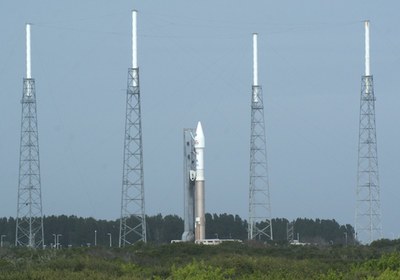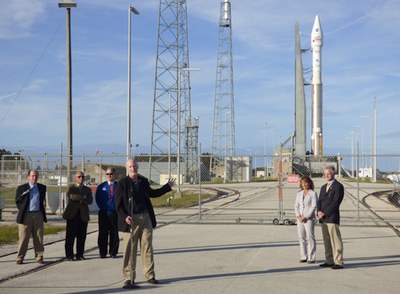“Hey, we’re going to Mars!”: MAVEN prepares for launchby Jeff Foust
|
| “I have every emotion going through me,” said Jakosky on Sunday. |
For Bruce Jakosky, the principal investigator for NASA’s Mars Atmosphere and Volatile EvolutioN (MAVEN) mission, the answer is, well, yes. “It really is all of the above,” he said at a pre-launch briefing Sunday morning at the Kennedy Space Center. “I don’t know how to put it into words what it feels like to be down to the day before launch.”
Later in the day, at a brief media opportunity outside the gates of Launch Complex 41, where the Atlas V rocket carrying MAVEN will launch, Jakosky said people have been asking him about his feelings all day. “The only possible answer is that I’m just beside myself,” he said. “I have every emotion going through me. To see this rocket behind us ready to go, to know that the spacecraft is inside, and to see the team members around here who have just put incredible effort and devotion into making sure this is going to work, it’s an indescribable feeling.”
Other than the throng of media taking pictures of Jakosky and others, including NASA administrator Charles Bolden, the scene at the pad Sunday afternoon was relatively quiet. Sunday was a day of rest for the launch team, who spent Saturday rolling out the Atlas from its nearby Vehicle Integration Facility to the pad and making final preparations for launch. On the day before launch, officials reported no problems with either the rocket or the spacecraft.
The biggest concern is, not surprisingly, the weather. Sunday was a warm, partly cloudy day: good conditions, by all appearances, for a launch. However, the forecast for Monday, when the two-hour launch window opens at 1:28 pm EST (1828 GMT), is a different story. An approaching cold front will bring with it clouds, rain, and winds; the timing of the front’s arrival will likely be the biggest factor in whether MAVEN starts its journey to Mars on time. Forecasts on Sunday called for a 60% chance of acceptable weather Monday, dropping to 40% Tuesday and Wednesday as the front stalls just to the south.
 The Atlas V rocket carrying MAVEN at the pad at Launch Complex 41 after its rollout Saturday morning. (credit: J. Foust) |
MAVEN already dodged one bullet last month when the federal government shut down in the midst of preparing the spacecraft for launch. “We’ve got all kinds of contingency plans in place: hurricane plans, plans if you have security breaches; you have plans for everything. Nobody could forecast this need to shut down the government,” recalled NASA launch director Omar Baez at a briefing Friday. Processing work stopped on October 1, but the program got a reprieve two days later when NASA determined that MAVEN was critical to the operations of ongoing missions—it has a communications relay to support spacecraft on the surface—and thus met the administration’s criteria for an essential program that could continue working during the shutdown. “It was an unnecessary distraction, but we overcame it.”
A weather-related delay of even a few days should not be a major issue for the mission, beyond extending any anxiety among team members. The launch window for MAVEN extends though early December, although an on-time launch Monday and successful initial checkout of MAVEN would allow it to accomplish some opportunistic science: observations of Comet ISON using the spacecraft’s Imaging Ultraviolet Spectrograph (IUVS) instrument as the comet swings around the Sun. “What an ideal opportunity for us to try out our instrument and do some good science along the way,” said Nick Schneider, who leads the IUVS team, at a Sunday morning briefing.
MAVEN’s primary mission, though, begins when it arrives at Mars in September 2014 and enters an elliptical orbit around the planet. The spacecraft will study the planet’s upper atmosphere to help scientists understand the processes that cause the atmosphere to escape to space, and thus determine if that led to the loss of the thicker atmosphere Mars had early in its history (see “Flying above the Martian radar”, The Space Review, September 3, 2013).
Because that thicker atmosphere allowed Mars to be warmer, and support liquid water—and, potentially, life—in its early history, the interest in this mission goes beyond the esoteric details of the interaction of solar wind and magnetic fields with neutral and charged particles in the upper Martian atmosphere. “I see this mission, at its core, as an astrobiology mission,” Jakosky said Sunday. “Something fundamentally changed, and we want to understand what those changes were. I really do see this as a mission about the history of Martian habitability.”
| “Hopefully, all of you understand that MAVEN is one more step in the journey of putting humans on the surface of Mars,” Bolden said. |
NASA has also emphasized the role MAVEN can play in supporting the agency’s long-term goals of sending people to Mars. “The MAVEN mission will provide some interesting information for the scientists,” said William Gerstenmaier, NASA associate administrator for human exploration and operations, in a separate briefing Sunday. “It’s also kind of good information for us on the human spaceflight front.” That includes, he explained, a better understanding of the Martian atmosphere to aid in the development of entry, descent, and landing systems for future Mars landers, as well as what resources the atmosphere could provide for future exploration.
“Hopefully, all of you understand that MAVEN is one more step in the journey of putting humans on the surface of Mars,” NASA administrator Bolden said, standing outside the launch pad Sunday afternoon. “It’s a very important step, because it’s going to help us understand much more than we have ever understood about Mars’s upper atmosphere.”
It’s also a step in a more secure Mars exploration program, at least in the near term. When Curiosity landed on Mars last August, MAVEN was the last Mars mission in the queue for NASA for the foreseeable future, after NASA earlier in the year withdrew from Europe’s ExoMars missions later in the decade. MAVEN, though, is no longer the end of the line: shortly after the Curiosity landing, NASA selected the InSight lander to launch to Mars in 2016 as the latest mission in its Discovery program of Mars missions, and last December announced plans to send a rover based on Curiosity to Mars in 2020, most likely to collect samples for return to Earth by a later mission.
Those selections have caused some grumbling in the planetary science community, particularly among scientists who feel missions elsewhere in the solar system are being shortchanged in favor of NASA’s focus on Mars. But at the Kennedy Space Center this weekend, the focus was on MAVEN as the next step in studying Mars, setting the stage for those future missions and, eventually, people. “Hopefully, we’ll have a good launch tomorrow and we’ll be off on an incredible journey to Mars,” Bolden said Sunday.
And while Jakosky said he was experiencing an indescribable mix of feelings, he sounded simply pretty excited Sunday afternoon, gesturing to the rocket standing behind him set to launch MAVEN. “Hey, we’re going to Mars!”
